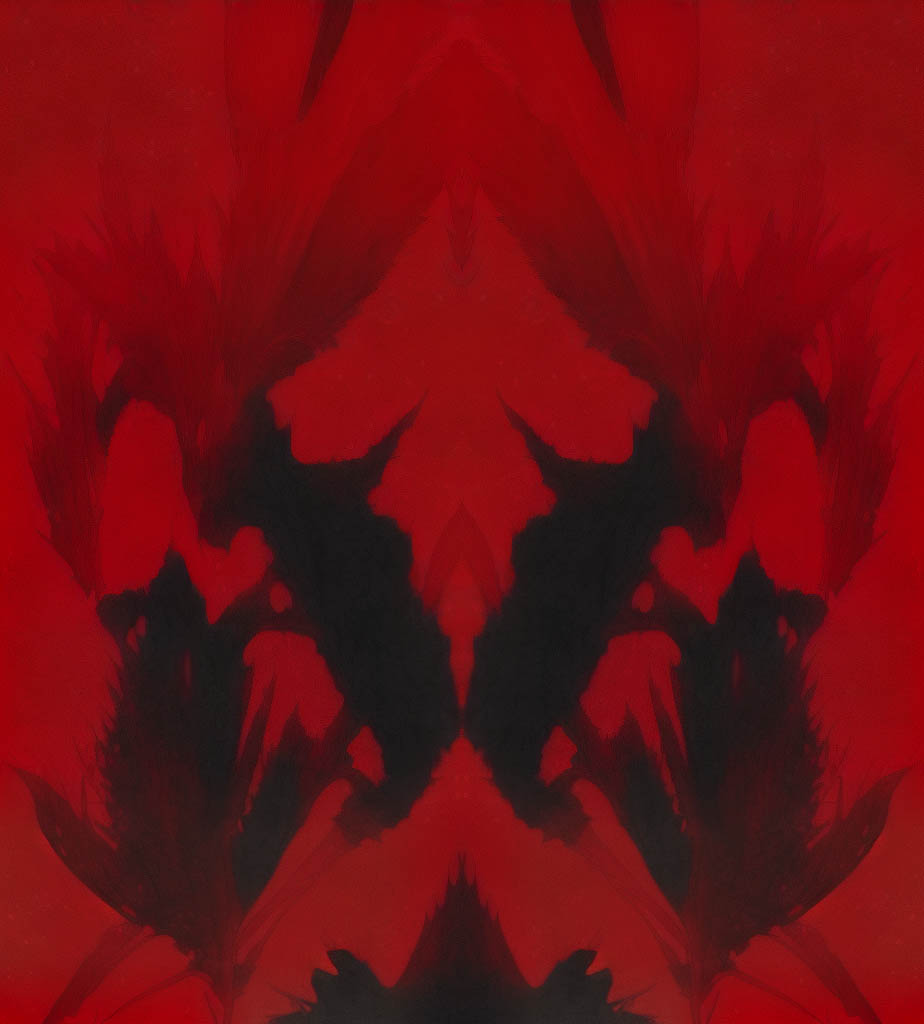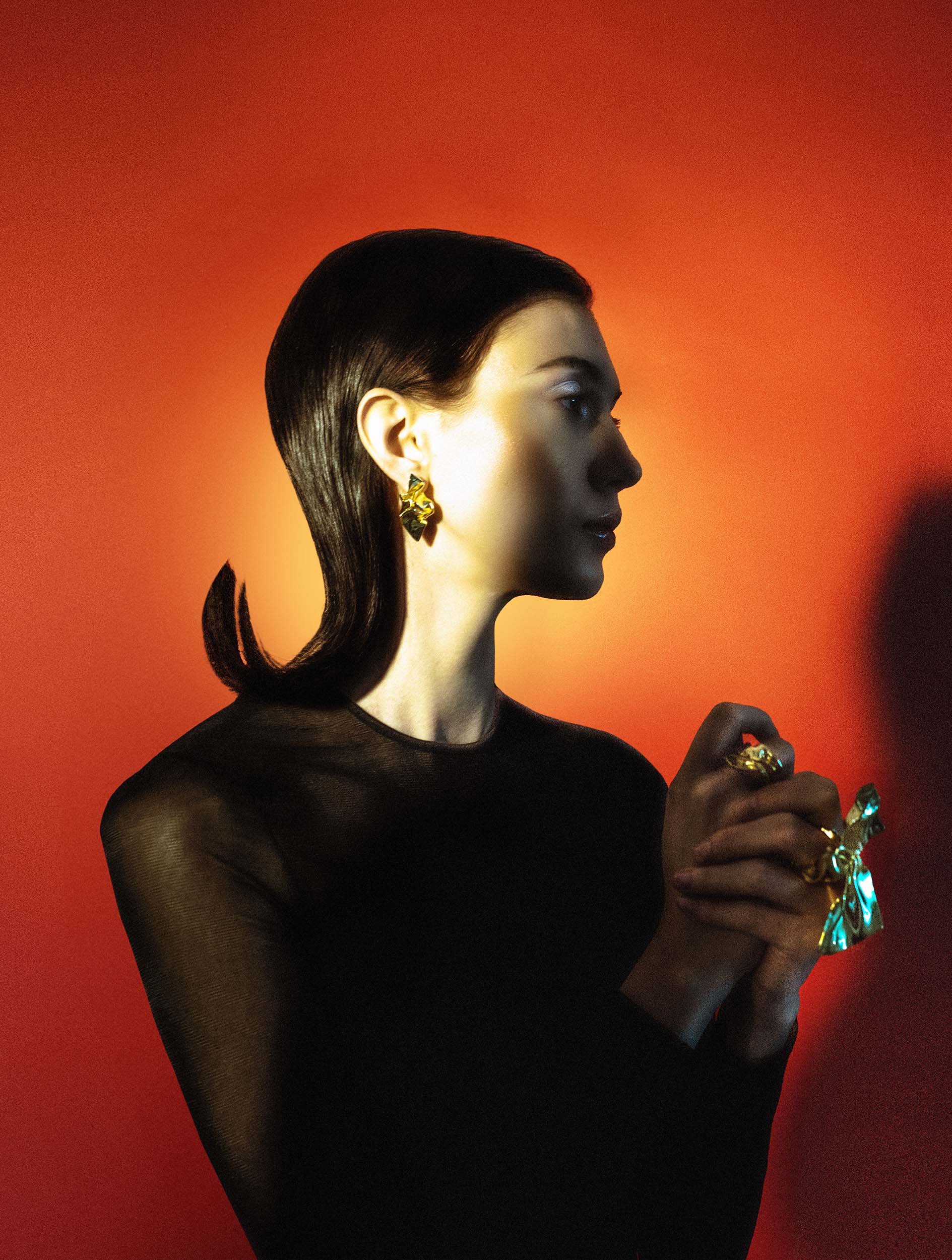Psyche
hysteria
Affectus
Psyche
hysteria
Affectus
Psyche
hysteria
Affectus
De-re-unconstructing fashion. A conversation with three avant-guard designers shaping a new aesthetic era.
Interview and text Giulia Giudici
G – First of all, what do you see in this ink blot?
N – I admit I’ve never taken this kind of test. This image gives off a sense of formidable strength, and I see natural shapes and patterns in it which remind me of Alexander McQueen’s Plato’s Atlantis collection.
G – I’m starting all these interviews with a question about childhood, as I think it is the most inescapably universal of common experiences.
We’ve all been kids, but we’ve all been different kids. It’s interesting to see how as children we’re walking antennae and receptors, hoovering in the different environments and stimuli we encounter and printing them perpetually into our brain – with radically different effects for each of us. We change so much throughout the years, and yet if you squint you can see when the seeds of your personality, taste and passion were first planted.
Exploring your memories, can you find traces of your current profession in your childhood?
N – I grew up surrounded by women working in a variety of fields such as fashion, pottery and homemade knitting. Certainly this instilled in me a knowledge and eye for form, beauty and product crafting. Since I was little I had a passion for dressing dolls, and by the time I was 6 years old, I had already created my own style.
In addition, my parents owned an aquarium store, and I would spend hours marveling at the movements and colors of those fish. I remember I loved drawing and getting lost in my thoughts, lying on the floor like a budding child painter. I would also admire Mom doing her makeup and hair in the bathroom.
Aesthetics was something I always understood.
G – As kids, almost all of us aspire to become iconic figures like pop star, teacher, pilot, cook, astronaut. Then, growing up, you’re progressively exposed to a whole world of other jobs (and, in recent years, brand new jobs, with mysterious names like NFT artist and blockchain developer).
Your path started with ceramics and then moved on to fashion. When did you discover the profession of ceramist, and then of fashion and jewelry designer? Did they immediately spark in you a sense of belonging, or did you come to this role later, by another route?
N – My artistic journey began in Faenza, where I attended the art school. There, I discovered ceramics, a fascinating material that I still use today to shape the first prototypes that I then transform into jewelry. During my studies in Turin (Fashion Design -ndr), I started to apply my sculptural approach to the body, shaping it in movement and bringing it to life through new forms and volumes – you see, the transition to fashion was spontaneous.
Today I also use contemporary technologies such as 3D printing to translate my art into jewelry, but I still feel a sense of belonging towards ceramic.
I shape fabric, I shape matter, and everything has balance.
G – The name of your brand is a play on the name of your hometown, Faenza. Can you tell us more about it?
N – Faenza is the heart of all my research, the home of great ceramic artists of the 1960s such as Carlo Zauli and Ivo Sassi. Faïence, the French name for Faenza, is the French and English term for tin-glazed pottery. This is where my studio is located, my brand and I are de Faïence.
The name is also a play on the words ‘defiance’ and ‘défaillance’, representing respectively an element of challenging obstacles and stereotypes, and an element of recognizing your imperfections and shortcomings and working on them.
G – What influence do you think Faenza, as a place and as a community, had (and still has) on your growth and path?
I believe that clay is a unique material, mother of all things. This is what makes the act of creating even more exciting. There is life in my creations.
The tradition of ceramics is still very much alive today in Faenza, a city that mostly thrives off artistic ceramic production. It hosts several fairs and events that gather artists from all over the world, and it is home to the International Museum of Ceramics, which I visit before starting any new collection.
Faenza continuously inspires me. It always reveals to me new interpretations of this unique material that has endless avenues of expression.
G – What is a défaillance, an obstacle or disappointment that you have encountered with your brand?
N – As you know, in May 2023 a flood hit the Romagna region. My house and studio were destroyed, and consequently all my work, materials and instruments. A good 8 meters of water and clay mud covered my life for days.
Despite all I lost, I am grateful that it happened to me because it gave me new awareness, and confirmed my tenacity to work hard for what I want.
I also thank all the people who helped me rebuild the new studio, and the company in Monza which donated sewing machines, tables and irons to me. I am moved by this demonstration of solidarity and generosity.




G – Rebuilding your house, your studio, your work is a pretty big act of defiance, I’d say.
N – Yes! This idea of starting anew after losing everything has a deep spiritual resonance for me, and I’ve channeled it into my work. I’m about to release my newest collection, which is inspired by the anqā, the Arabian phoenix, a symbol of both rebirth and misfortune. The main colors are black and white: the ying and the yang, the balance of good and evil, the chance to create that comes with destruction.
G – Speaking of duality, creator and creation are intricately entwined. Do you see DEFAÏENCE as a separate creature with its own autonomous life, or is it an extension of you, a part of you that manifests itself through clay and fabric?
N – It is its own creature. My goal for my brand is not for it to be subservient to my ego – I have created it with its own vision, language and set of beliefs.
At the moment, the brand has no reason to exist without its creator, but at the same time the identity I am creating for it also influences my research and expression. We feed off each other, symbiotically. In the more or less distant future, I’d be even open to involving other people who’ll interpret the vision of DEFAÏENCE in their own way, as happened with Alexander McQueen, Vivienne Westwood, Versace…
G – Another interesting duality is that of ceramic and fabric: two fundamentally different materials. Ceramic always starts off as an amorphous mass with a finite set of properties, but it can be molded into an infinite range of shapes and finishings – it requires more input by the ceramist, but offers more room for their personal interpretation. On the other hand, fabric comes in a great variety of materials, qualities, textures, weights… This initial set of properties tells a story on its own, which is then interpreted by the designer – but once the garment is worn, it is the wearer who has the final say.
Do you use a different approach for these two materials?
N – My vision consists in building shapes and volumes, playing with silhouettes, with both ceramic and fabric.
Ceramic requires only my dexterity and experience; it offers the greatest freedom of expression because it is I who gives it all its final characteristics, fulfilling my exact vision. On the other hand, fabric engages its wearer in the storytelling. Garments are versatile, they move on the body and with the body, they interact with the rest of the outfit.
However, my ceramic jewelry are something you wear, so the same idea stands. I see them as amulets, with an energy of their own: there is no transformation of shape, but of meaning.
Nicola Bacchilega was born in Faenza in 1990 where he studied Ceramic Sculpture and then Fashion Design in Turin. In September 2021, he founded DEFAÏENCE, a ready-to-wear clothing and accessories brand inspired by the designer’s background.
Photo courtesy of Nicola Bacchilega. Photographer Matei Octav, Art Direction Fattura Studio
copyright 2023 – The Metalhead Magazine